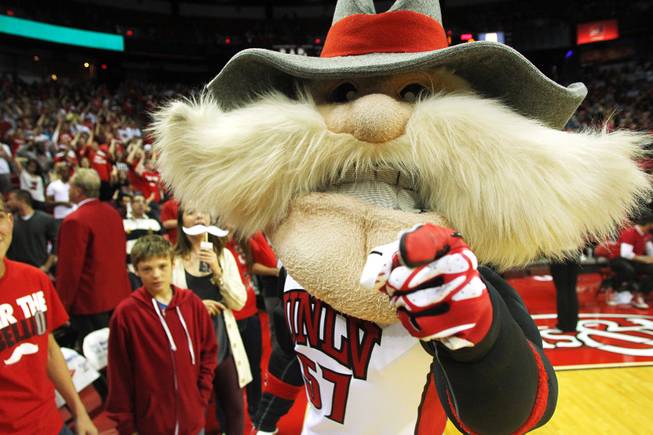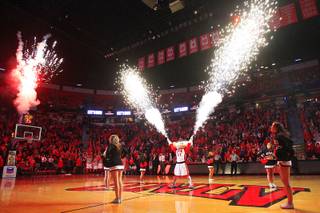
Las Vegas Sun
Hey Reb points a finger before UNLV’s season opener against Portland State on Friday, Nov. 11, 2013, at the Thomas & Mack Center. UNLV won 67-48.
Thursday, Dec. 3, 2015 | 2 a.m.
A popular refrain among defenders of UNLV’s nickname and mascot is that “history matters.”
And recently, when a group of students at the university called the symbols racist and demanded that they be thrown out, supporters quickly pointed to the college’s well-documented attempts to distance itself from any association with the southern Confederacy.
On Monday, the supporters were handed a victory when university President Len Jessup declared the symbols weren’t inspired by the Confederacy, and made public a 60-page report by the university’s diversity chief, Rainier Spencer.
While opponents of Hey Reb! and the “Rebels” nickname probably won’t agree with Spencer’s conclusions, the report is an interesting look at the history of the issue.
Here are some of the more noteworthy excerpts:
“According to [Freddie Banks], when the team went out of state everyone knew the Rebels and the exciting brand of basketball they brought with them. He said that 'Everyone wants to be a Runnin’ Rebel,' and he wondered what we would be if we stopped being Rebels — the UNLV Coyotes?”
The opinions of former student-athletes like “Fearless” Freddie Banks, who played for the Runnin’ Rebels from 1983 to 1987 before being drafted by the Detroit Pistons, were sought by UNLV, not least because much of the early pushback against the school’s Confederate imagery came from school athletes. Banks, who is black, has since turned to coaching youth sports in Las Vegas, but his views seem to represent how many former Runnin’ Rebels feel about the nickname as well as the mascot. Spencer also spoke to Banks’ contemporary Eldridge Hudson, who said he considered Hey Reb! “like our little Rebel dude.” Surprisingly, the most significant pushback against the nickname seemed to come from UNLV basketball legend and current assistant coach Stacey Augmon, according to the report. He told the university that he never associated the name with the Confederacy, but that in light of student concerns it perhaps “was a good time for a change.” But Banks also poses a question often left out of the debate: What would the school’s nickname be if not the Rebels? Many argue that the “Runnin’ Rebels” brand is integral to the college’s national image, though that argument is commonly made wherever there are calls to get rid of mascots. For what it’s worth, in the 1960s students suggested the nickname be changed to “Sidewinders,” though obviously that didn’t catch on.
“It is a character that well represents a rebel, a mountain man,” said Les Raschko, public information services director. “We don’t think it will be offensive to any particular group.”
Raschko’s quote might seem ironic given the recent controversy, but it’s indicative of the thinking that went into the creation of the modern day Hey Reb! At the time he said the above quote, Raschko was the chairman of the 1982 Mascot Committee, formed in the wake of student discontent over the school’s lack of a mascot since the Confederate wolf Beauregard was scrapped in the 1970s. It was a goal from the outset of the process that any new mascot be designed in such a way that would avoid offending anyone. Spencer delved into the minutes of a September committee meeting, where then-Director of Alumni Relations Fred Albrecht was quoted as saying, “whatever mascot design the committee picked … anything identifying with the confederate symbol would still offend black students/athletes.” The committee eventually decided to go with the Hey Reb! design, and Raschko’s above quote was reported by the UNLV student newspaper on Dec. 9, 1982, the same day the new mascot debuted in a basketball game between UNLV and its rival UNR. In the same article, the student newspaper wrote, “The committee chose 'Hey, Reb' because it seemed to best represent the image of a Westerner, rather than a Confederate rebel.” To Spencer, this constituted proof that Hey Reb! was not a Confederate symbol. “The above description of Hey Reb! leaves no doubt whatsoever that everything about the way he looks was designed expressly to represent a 19th-century pathfinder,” he wrote. “The claim that his outfit or anything about him is Confederate is simply inaccurate.”
“All passing through [Southern Nevada] stopped at the Springs and at Blue Diamond for the only sources of water. John C. Fremont on his military mapping, Kit Carson as a scout, Bonneville and many more. Just note all the streets that are named for them in the downtown area. I fashioned [Hey Reb!] after those pathfinders and explorers. His leathers, feather and robes were common for the times.”
That quote is from an email to UNLV alumni relations official Jim Ratigan from Mike Miller, who created the design of Hey Reb! and sold it to UNLV for $1. The email was included in the report, and details Miller’s intention to make the mascot reflect the kind of “mountain man” whose history is intertwined with that of many Western states. In addition to a handful of streets named after mountain men in downtown Las Vegas, a number of schools in the Clark County School District have been named after early pioneers as well, including John C. Fremont Middle School, Kit Carson Elementary and Jim Bridger Middle School. Part of the confusion about the mascot’s roots could stem from how it is commonly depicted in public. For instance, past iterations of Hey Reb! show him wearing the frilly robes and chaps Miller mentions, but that has morphed over time. Now the costume currently worn at basketball and football games depicts Hey Reb!’s head on top of a regular body wearing a sports jersey, which could lead many to assume his face was designed to resemble Colonel Reb, the former mascot of the University of Mississippi.
“... the traditional account of 'rebellion' against UNR being the source of a Rebels identity is unfounded, as the acrimony was actually directed against political forces in Carson City and Reno, not against the University of Nevada itself.”
Spencer also attempted to correct the record on a common argument made by supporters of the Rebels nickname: that the moniker was adopted by students in defiance of UNR. The nickname was adopted in the mid-1950s when UNLV was still a satellite campus of UNR called Nevada Southern. The fledgling school quickly ran into the problem that has defined much of Nevada’s political landscape for decades: tensions between the state's northern and southern populations. Although Nevada Southern was technically part of UNR, legislators in Carson City were decidedly stacked in favor of Reno and the state’s rural counties. For decades the state Senate followed an archaic model of allowing only one senator from each county regardless of population. Clark County was outnumbered in the statehouse 16-1, which meant it often lost out on valuable funding even though it had the largest population. According to the report, this also extended to the students of Nevada Southern, who tried in vain to obtain much needed funds to expand the overcrowded campus but were told the money would instead go to UNR. Wrote one Nevada Southern student in an article in the student newspaper in 1961, “We must face the fact that if we wait for the minds in Reno to make the decisions and to allocate the money which is needed to handle NSU, we will all be grandparents.” Outcry from students was aimed not at UNR specifically but at the politicians who held the purse strings, and the school’s “rebellious” reputation eventually manifested in Confederate imagery that began popping up in the form of Beauregard, the school’s first mascot and the appearance of the Confederate battle flag on the student newspaper’s masthead, among other places.
“Some might argue that there is a measure of poetic justice or penance in Beauregard’s having been forced to exist beneath the fossilized remains of an aquatic reptile for over a decade.”
OK, this one is an inside joke that likely make sense only to knowledgeable UNLV students and staff. After Beauregard the Confederate wolf was scrapped as UNLV’s unofficial mascot in the 1970s, the university bent over backwards to erase any evidence of him around campus. But one image still remains: His likeness on the floor of UNLV’s old gymnasium, now the Marjorie Barrick Museum. In the 1960s, the university performed its graduation ceremonies on the basketball court, right on top of Beauregard’s face. The building was converted into a museum in the 1970s, and the image was nearly destroyed before an official stepped in to prevent it from being “sanded away into oblivion by a remodeling crew.” The new museum began featuring exhibits about natural history. The first major display: The fossil of an ichthyosaur, a prehistoric sea creature. The museum has since been changed to house art exhibits, but the face of Beauregard is still there.


Join the Discussion:
Check this out for a full explanation of our conversion to the LiveFyre commenting system and instructions on how to sign up for an account.
Full comments policy